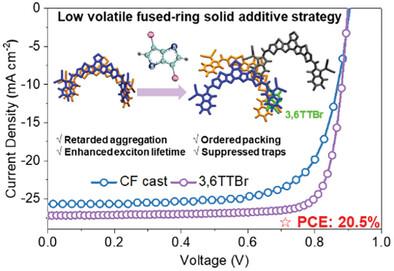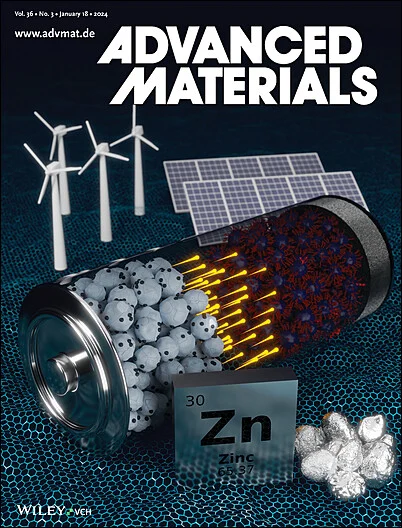Low‐Volatility Fused‐Ring Solid Additive Engineering for Synergistically Elongating Exciton Lifetime and Mitigating Trap Density Toward Organic Solar Cells of 20.5% Efficiency
IF 27.4
1区 材料科学
Q1 CHEMISTRY, MULTIDISCIPLINARY
引用次数: 0
Abstract
Volatile solid additives (VSAs) with single or fused‐ring structures have attracted much attention for enhancing power conversion efficiencies (PCEs) of organic solar cells (OSCs). While the working mechanisms of high‐volatility single‐ring additives have been well studied, the influence of low‐volatility fused‐ring VSAs on molecular aggregations and exciton/carrier dynamics remains still unclear. Herein, 3,6‐dibromothieno[3,2‐b]thiophene (3,6TTBr) is selected as a representative low‐volatility fused‐ring VSA to elucidate its working mechanism. Via the theoretical and experimental joint investigation, it is found that rigid and planar 3,6TTBr molecules adsorb onto the terminal units of L8‐BO (acceptor), inducing loose space for adjacent molecules. The low‐volatility 3,6TTBr thus favors the L8‐BO center‐terminal packing with a larger interfragment distance, which relieves the L8‐BO over‐aggregation and induces the ordered packing. Consequently, the 3,6TTBr treatment reduces aggregation‐caused quenching, enhancing the photoluminescence quantum yield and exciton lifetime of L8‐BO film. The combination of the above properties with the reduced trap density and improved carrier transport in the 3,6TTBr‐treated devices contributed to PCE of 20.1%. To validate the broad applicability of the findings, 1,5‐dibromonaphthalene (1,5‐BN), another low‐volatility fused‐ring solid, is explored. The devices with 1,5‐BN achieved an impressive PCE of 20.5%, verifying the validity of the low‐volatility fused‐ring VSA strategy for boosting OSC performances.

求助全文
约1分钟内获得全文
求助全文
来源期刊

Advanced Materials
工程技术-材料科学:综合
CiteScore
43.00
自引率
4.10%
发文量
2182
审稿时长
2 months
期刊介绍:
Advanced Materials, one of the world's most prestigious journals and the foundation of the Advanced portfolio, is the home of choice for best-in-class materials science for more than 30 years. Following this fast-growing and interdisciplinary field, we are considering and publishing the most important discoveries on any and all materials from materials scientists, chemists, physicists, engineers as well as health and life scientists and bringing you the latest results and trends in modern materials-related research every week.
 求助内容:
求助内容: 应助结果提醒方式:
应助结果提醒方式:


